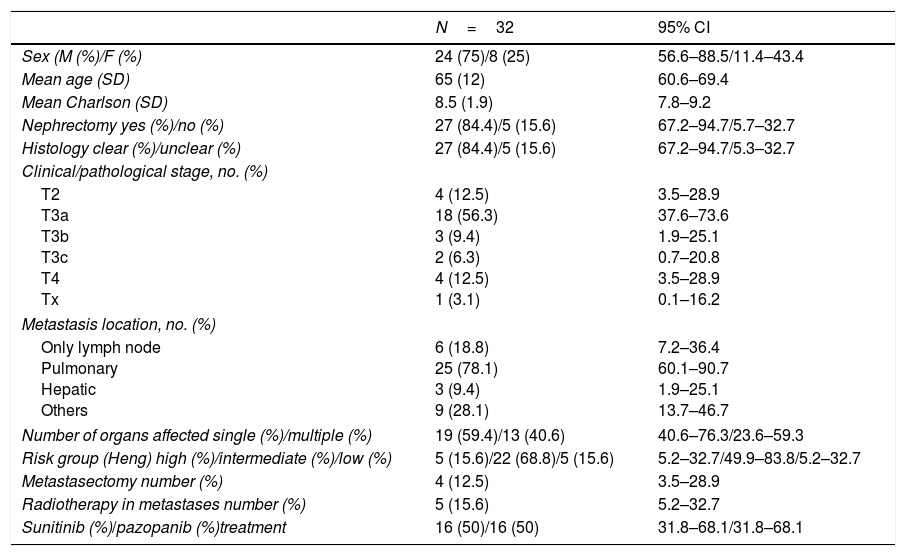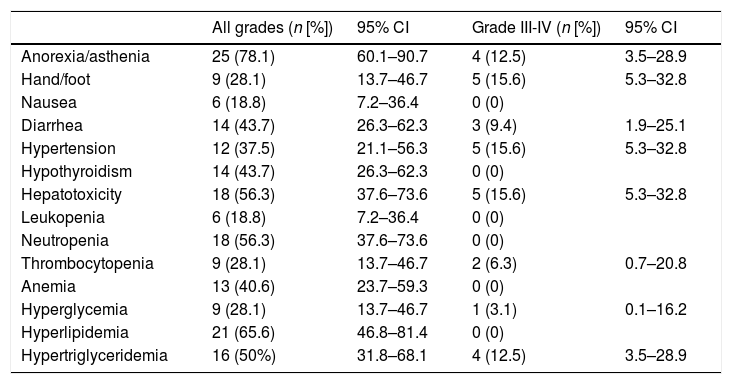To analyze the learning curve for the management of tyrosine kinase inhibitors as the first line of treatment for patients with metastatic renal cancer.
Material and methodsWe evaluated 32 consecutive patients treated in our department for metastatic renal cancer with tyrosine kinase inhibitors (pazopanib or sunitinib) as first-line treatment between September 2012 and November 2015. We retrospectively analyzed this sample. We measured the time to the withdrawal of the first-line treatment, the time to progression and overall survival using Kaplan–Meier curves. The learning curve was analyzed with the cumulative sum (CUSUM) methodology.
ResultsIn our series, the median time to the withdrawal of the first-line treatment was 11 months (95% CI 4.9–17.1). The mean time to progression was 30.4 months (95% CI 22.7–38.1), and the mean overall survival was 34.9 months (95% CI 27.8–42). By applying the CUSUM methodology, we obtained a graph for the CUSUM value of the time to withdrawal of the first-line treatment (CUSUM TW), observing 3 well-differentiated phases: phase 1 or initial learning phase (1–15), phase 2 (16–26) in which the management of the drug progressively improved and phase 3 (27–32) of maximum experience or mastery of the management of these drugs. The number of treated patients needed to achieve the proper management of these patients was estimated at 15.
ConclusionsDespite the limitations of the sample size and follow-up time, we estimated (in 15 patients) the number needed to reach the necessary experience in the management of these patients with tyrosine kinase inhibitors. We observed no relationship between the time to the withdrawal of the first-line treatment for any cause and progression.
Analizar la curva de aprendizaje en el manejo de los inhibidores de la tirosina quinasa como primera línea en el tratamiento de los paciente con cáncer renal metastásico.
Material y métodosEvaluamos 32 pacientes consecutivos tratados en nuestro servicio de cáncer renal metastásico con inhibidores de la tirosina quinasa (pazopanib o sunitinib) en primera línea entre septiembre de 2012 y noviembre de 2015. Analizamos retrospectivamente dicha muestra. Medimos tiempo hasta retirada de primera línea, tiempo hasta progresión y supervivencia global mediante curvas de Kaplan Meier. La curva de aprendizaje fue analizada con «cumulative sum (CUSUM) methodology».
ResultadosEn nuestra serie la mediana hasta la retirada de primera línea fue de 11 meses (IC 95% 4,9-17,1). El tiempo medio hasta progresión 30,4 meses (IC 95% 22,7-38,1) y la media de la supervivencia global 34,9 meses (IC 95% 27,8-42). Al aplicar la metodología CUSUM obtenemos una gráfica para el valor CUSUM tiempo hasta retirada de la primera línea (CUSUM TR) observando 3 fases bien diferenciadas: fase 1 o fase de aprendizaje inicial (1-15), fase 2 (16-26) en el que se mejora progresivamente el manejo del fármaco y una tercera fase (27-32) de máxima experiencia o maestría en el manejo de estos fármacos. Estimamos en 15 el número necesario de pacientes tratados para conseguir el manejo adecuado de estos pacientes.
ConclusionesPese a la limitación del tamaño muestral y el tiempo de seguimiento estimamos en 15 pacientes el número necesario para alcanzar el nivel de experiencia óptimo de madurez en el manejo con inhibidores de la tirosina quinasa de estos pacientes. No observamos relación entre el tiempo hasta retirada de primera línea por cualquier causa y la progresión.













